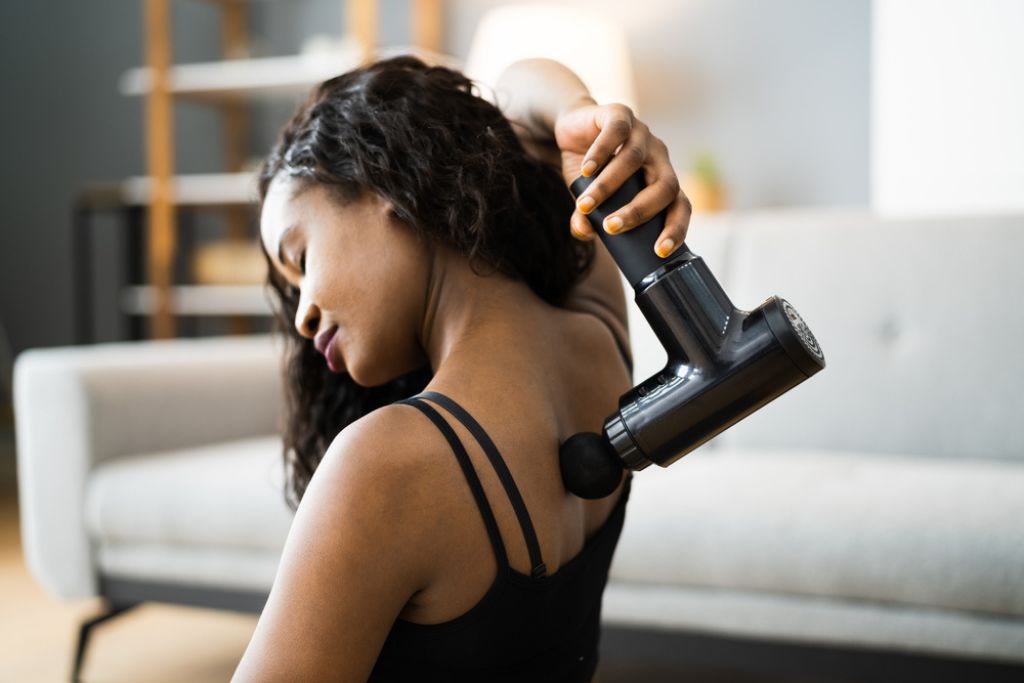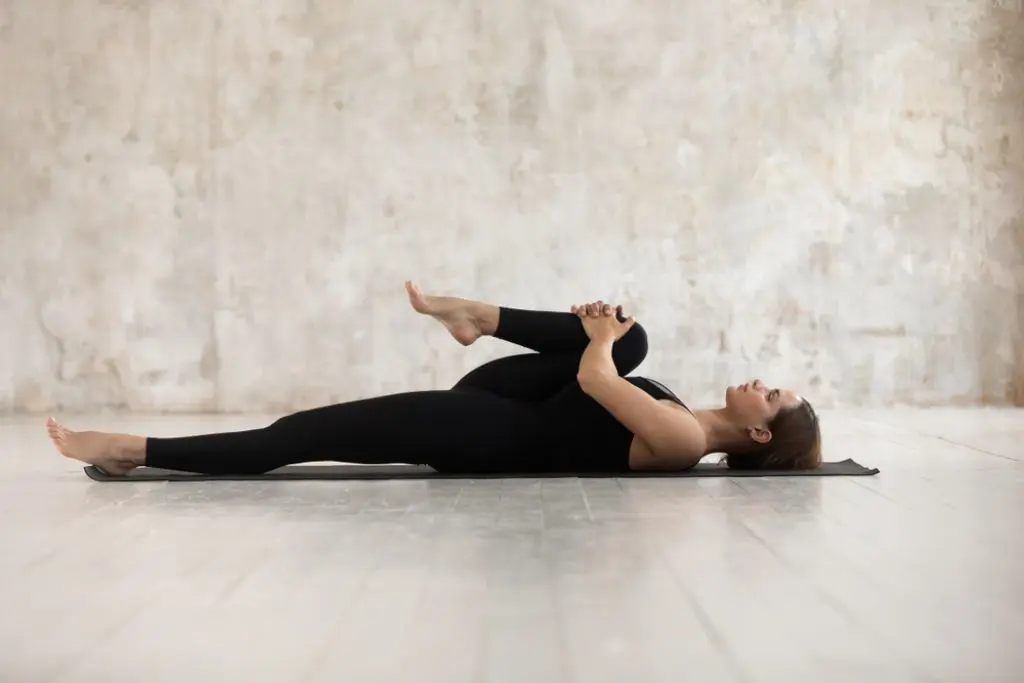Do Massage Guns Work For Muscle Recovery?

November 28, 2023

We love a good health hack just as much as you do, and we’re all about finding fast, effective ways to speed up post-workout recovery. Massage guns have skyrocketed in popularity in recent years as a recovery tool for self-massage and relieving workout aches, so we wanted to know if this trending product is worth the hype.
How do massage guns work?
According to the Cleveland Clinic, percussive massage guns use vibrations to warm your muscle tissue and increase blood flow to the areas you’re targeting by repeatedly impacting the soft tissue. Using a massage gun is intended to relieve muscle tightness, provide stress relief and improve post-workout DOMS.
While some people use a massage gun as a pre-workout tool to warm up the muscles, they’re more widely used after you work out. Simply turn the gun on after your Sweat session, select your desired intensity, and hold the head of the gun gently against your muscles as it vibrates like a mini jackhammer. If you’ve ever heard of percussive or vibration therapy - that’s exactly what massage guns deliver!
As the Cleveland Clinic says, a massage gun is thought to achieve similar effects to stretching or foam rolling, with the obvious benefit that you can do it yourself while sitting down.
What does the research say about massage guns?
Because massage guns are relatively new as a recovery tool, the evidence and research on their benefits are still quite limited - especially when ratings of soreness and relief are generally self-reported.
One study from 2014 compared the effects of vibration therapy and massage in the prevention of delayed onset muscle soreness (DOMS), and both were found to be equally effective. Another meta-analysis from 2019 aimed to evaluate the effectiveness of vibration, reviewing 10 studies with 258 participants. They found that vibration can be a beneficial form of physiotherapy for alleviating DOMS, but stated that further research is needed to understand the role and mechanics of vibration for muscle recovery.
The Cleveland Clinic also adds that while massage guns may improve your perception of muscle soreness or fatigue, they have not been proven to improve your athletic performance in terms of speed, power or endurance.

What else can you do for muscle recovery?
If you’ve already got a massage gun and feel like it’s working wonders for your muscles - amazing. But if you’re feeling the effects of your workouts (aka having trouble walking up stairs) and are looking for general tips on what to do - there are plenty of other proven methods of supporting muscle recovery that don’t involve buying a fancy gadget. Think of a massage gun like a recovery garnish rather than the main course! Other strategies we recommend to take care of your muscles and alleviate soreness:
Warm up properly with some light cardio or dynamic stretches before every workout and spend 5-10 minutes cooling down and stretching after you work out. Every workout in the Sweat app is accompanied by an optional warm-up and cool-down and we highly recommend you don’t skip them!
Prioritise rest - both in terms of rest days and quality sleep
Drink plenty of fluids - staying hydrated helps to replace electrolytes and transport nutrients to your muscles
Include a good source of protein in each meal
Enjoy (endure is probably more accurate) regular foam-rolling sessions
Increase the intensity of your workouts gradually! There’s no point in pushing yourself so hard that you can’t exercise for a week
Make time for relaxation and downtime, as lower levels of stress are associated with superior recovery
Include mobility training in your routine. Kelly MacDonald’s Mobility & Strength in Motion program is a great place to start!
Massage gun vs foam roller - what to choose?
If you’re trying to choose between buying a foam roller and a massage gun, consider how much you’re willing to spend, how and when you want to use it, and what you think you’ll use more often. Depending on what’s most important to you, you may want to consider factors such as:
A foam roller is more affordable
It’s easier to target larger areas of muscle with a foam roller
A massage gun is smaller
Most gyms have access to foam rollers
A massage gun can give more targeted massage
A massage gun can be used in a passive way, such as sitting on the couch or lying in bed. A foam roller, not so much!
Foam rolling features in many Sweat app recovery sessions if you want something to follow.

Tips for using a massage gun
A common misconception about massage guns is that the higher the intensity and the more pressure you apply, the more benefits you’ll receive, but a massage gun is not the same thing as a deep-tissue sports massage. If used improperly, a massage gun can cause damage.
If you’re wanting deep relief or have significantly sore or tight muscles, you’re better off in the hands of a skilled professional who will understand and work with your body in a way a massage gun never will. A massage gun doesn’t know the difference between your muscles, bones, joints and nerves and it certainly isn’t going to alert you to an injury or stop if you’re using it incorrectly. To look after your body and use your massage gun correctly, here are a few tips.
Start on a low setting If it’s your first time trying a massage gun, always start with a low intensity and see how it feels (both while you’re using it and the next day) before you think about increasing it.
Gently does it When you do apply it to your muscle, you don’t need to press overly hard or aim to cause yourself pain - simply hold it gently on the muscle. Most massage guns also come with different shaped attachments so you can change the level of pressure if it doesn’t feel right.
Go slow, but for a short time Don’t rush as you move the massage gun across your muscles, but also know that spending a few minutes on a muscle group is plenty. Moving the gun at a slower pace will also help you to feel when you hit a sore spot where you might want to spend more time or work on with some additional stretching.
Avoid bones and joints Plain and simple - a massage gun is for your muscles. Keep it away from those knobbly and nervy bits.
Relaaax Using a massage gun on tense muscles can increase your risk of bruising or damage, so try your best to relax.
Don’t use it for injuries or conditions Using a massage gun for post-workout aches is one thing, but you should always see a professional to treat an injury or significant pain, or ask your healthcare provider for advice if you have an underlying medical condition.
The bottom line? Because further research is still needed to understand the benefits of massage guns, it’s best to use them as a recovery add-on if you notice the benefits, continue to prioritise other recovery strategies, and never use them instead of seeing a professional if you have severe pain or an injury.

A more empowered you starts with Sweat, and our editorial team is here to bring you the latest fitness tips, trainer recommendations, wellbeing news, nutritional advice, nourishing recipes and free workouts.
* Disclaimer: This blog post is not intended to replace the advice of a medical professional. The above information should not be used to diagnose, treat, or prevent any disease or medical condition. Please consult your doctor before making any changes to your diet, sleep methods, daily activity, or fitness routine. Sweat assumes no responsibility for any personal injury or damage sustained by any recommendations, opinions, or advice given in this article.
Wellbeing